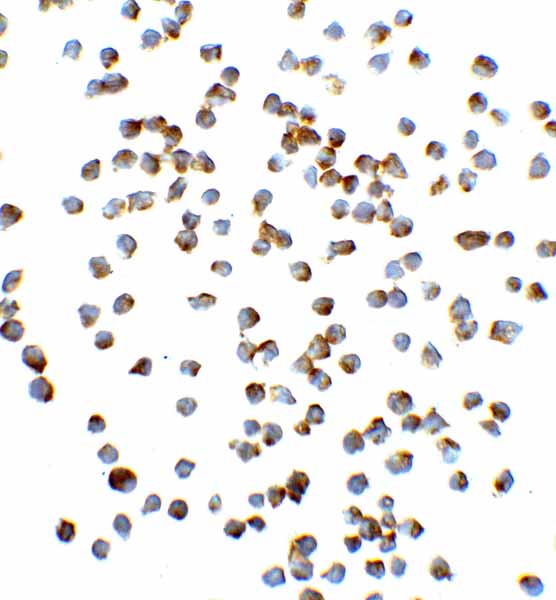SARM Antibody
- SPECIFICATION
- CITATIONS
- PROTOCOLS
- BACKGROUND

Application
| WB, IF, ICC, E |
|---|---|
| Primary Accession | Q6SZW1 |
| Other Accession | NP_055892, 23098 |
| Reactivity | Human, Mouse |
| Host | Rabbit |
| Clonality | Polyclonal |
| Isotype | IgG |
| Calculated MW | Predicted: 80 kDa Observed: 85 kDa |
| Application Notes | SARM antibody can be used for detection of SARM by Western blot at 0.5 to 1 μg/mL. Antibody can also be used for immunocytochemistry starting at 2 μg/mL. For immunofluorescence start at 2 μg/mL. |
| Gene ID | 23098 |
|---|---|
| Other Names | SARM Antibody: SARM, SAMD2, MyD88-5, KIAA0524, SARM, Sterile alpha and TIR motif-containing protein 1, Sterile alpha and Armadillo repeat protein, sterile alpha and TIR motif containing 1 |
| Target/Specificity | SARM antibody was raised against a peptide corresponding to 14 amino acids near the C-terminus of human SARM. The immunogen is located within amino acids 640 - 690 of SARM. |
| Reconstitution & Storage | SARM antibody can be stored at 4℃ for three months and -20℃, stable for up to one year. As with all antibodies care should be taken to avoid repeated freeze thaw cycles. Antibodies should not be exposed to prolonged high temperatures. |
| Precautions | SARM Antibody is for research use only and not for use in diagnostic or therapeutic procedures. |
| Name | SARM1 |
|---|---|
| Function | NAD(+) hydrolase, which plays a key role in axonal degeneration following injury by regulating NAD(+) metabolism (PubMed:25908823, PubMed:27671644, PubMed:28334607). Acts as a negative regulator of MYD88- and TRIF-dependent toll-like receptor signaling pathway by promoting Wallerian degeneration, an injury-induced form of programmed subcellular death which involves degeneration of an axon distal to the injury site (PubMed:15123841, PubMed:16964262, PubMed:20306472, PubMed:25908823). Wallerian degeneration is triggered by NAD(+) depletion: in response to injury, SARM1 is activated and catalyzes cleavage of NAD(+) into ADP-D-ribose (ADPR), cyclic ADPR (cADPR) and nicotinamide; NAD(+) cleavage promoting cytoskeletal degradation and axon destruction (PubMed:25908823, PubMed:28334607, PubMed:30333228, PubMed:31128467, PubMed:31439792, PubMed:31439793, PubMed:32049506, PubMed:32828421, PubMed:33053563). Also able to hydrolyze NADP(+), but not other NAD(+)-related molecules (PubMed:29395922). Can activate neuronal cell death in response to stress (PubMed:20306472). Regulates dendritic arborization through the MAPK4-JNK pathway (By similarity). Involved in innate immune response: inhibits both TICAM1/TRIF- and MYD88-dependent activation of JUN/AP-1, TRIF-dependent activation of NF-kappa-B and IRF3, and the phosphorylation of MAPK14/p38 (PubMed:16964262). |
| Cellular Location | Cytoplasm. Cell projection, axon {ECO:0000250|UniProtKB:Q6PDS3}. Cell projection, dendrite {ECO:0000250|UniProtKB:Q6PDS3}. Synapse {ECO:0000250|UniProtKB:Q6PDS3}. Mitochondrion Note=Associated with microtubules. {ECO:0000250|UniProtKB:Q6PDS3} |
| Tissue Location | Predominantly expressed in brain, kidney and liver. Expressed at lower level in placenta. |

Thousands of laboratories across the world have published research that depended on the performance of antibodies from Abcepta to advance their research. Check out links to articles that cite our products in major peer-reviewed journals, organized by research category.
info@abcepta.com, and receive a free "I Love Antibodies" mug.
Provided below are standard protocols that you may find useful for product applications.
Background
SARM Antibody: Toll-like receptors (TLRs) are signaling molecules that recognize different microbial products during infection and serve as an important link between the innate and adaptive immune responses. SARM (SAM and ARM-containing protein), along with other molecules such as TIRP, TRIF, TIRAP, and MyD88, is thought to serve as an adaptor protein for the TLRs that allows for the activation of downstream kinases and NF-κB, and ultimately the expression of proteins involved in host defense. While SARM has not been conclusively shown to associate directly with TLRs, the presence of a Toll-interluekin-1 (TIR) domain in SARM is consistent with a role as a signaling molecule.
References
Vogel SN, Fitzgerald KA, and Fenton MJ. TLRs: differential adapter utilization by toll-like receptors mediates TLR-specific patterns of gene expression. Mol. Interv. 2003; 3:466-77.
Takeda K, Kaisho T, and Akira S. Toll-like receptors. Annu. Rev. Immunol. 2003; 21:335-76.
Janeway CA Jr and Medzhitov R. Innate immune recognition. Annu. Rev. Immunol. 2002; 20:197-216.
O’Neill LAJ, Fitzgerald FA, and Bowie AG. The Toll-IL-1 receptor adaptor family grows to five members. Trends in Imm. 2003; 24:286-9.
If you have used an Abcepta product and would like to share how it has performed, please click on the "Submit Review" button and provide the requested information. Our staff will examine and post your review and contact you if needed.
If you have any additional inquiries please email technical services at tech@abcepta.com.













 Foundational characteristics of cancer include proliferation, angiogenesis, migration, evasion of apoptosis, and cellular immortality. Find key markers for these cellular processes and antibodies to detect them.
Foundational characteristics of cancer include proliferation, angiogenesis, migration, evasion of apoptosis, and cellular immortality. Find key markers for these cellular processes and antibodies to detect them. The SUMOplot™ Analysis Program predicts and scores sumoylation sites in your protein. SUMOylation is a post-translational modification involved in various cellular processes, such as nuclear-cytosolic transport, transcriptional regulation, apoptosis, protein stability, response to stress, and progression through the cell cycle.
The SUMOplot™ Analysis Program predicts and scores sumoylation sites in your protein. SUMOylation is a post-translational modification involved in various cellular processes, such as nuclear-cytosolic transport, transcriptional regulation, apoptosis, protein stability, response to stress, and progression through the cell cycle. The Autophagy Receptor Motif Plotter predicts and scores autophagy receptor binding sites in your protein. Identifying proteins connected to this pathway is critical to understanding the role of autophagy in physiological as well as pathological processes such as development, differentiation, neurodegenerative diseases, stress, infection, and cancer.
The Autophagy Receptor Motif Plotter predicts and scores autophagy receptor binding sites in your protein. Identifying proteins connected to this pathway is critical to understanding the role of autophagy in physiological as well as pathological processes such as development, differentiation, neurodegenerative diseases, stress, infection, and cancer.


